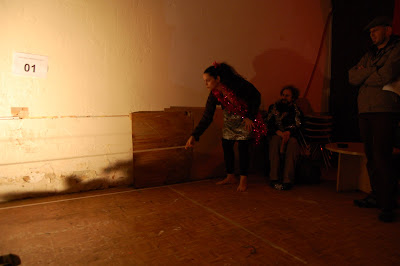HIGH HEEL MARATHON: To be a propper woman.
Performance
23 NOV 2010
ArtEvicT - London, UK.
Performance
23 NOV 2010
ArtEvicT - London, UK.
High Heel Marathon is a performance that reflects on the
Social Standards of Womanhood and the Aesthetic Rituals we –girls/women- go
through to try to achieve them by inviting the audience to witness a
Marathon-Race in high heels as a Ritual to become a “Real/Proper/Super Woman”.
As Simone de Beauvoir said:
"You're not born a woman, you become a woman."
"You're not born a woman, you become a woman."
We must ask ourselves, in every interpretation of rite, about “the social function of the rite and the social significance of the boundaries or limits that the ritual allows to cross in a legitimate way”
(Bourdieu 1997: 117).
Womanhood is the period in a female's life after she has transitioned through childhood and adolescente.
Many cultures have rites of passage to symbolize a girl's coming of age, such as confirmation in some branches of christianity, bat mitzvah, in Judaism, or even just the custom of a special celebration for a certain birthday (generally between 12 and 21), like the Quinceañera of Latin America.
"Femininity" is used to refer to a set of supposedly typical female qualities associated with a certain attitude to gender roles.
Reasons against wearing high-heels, which are almost exclusively health and practicality reasons, include:
- they can cause foot pain
- they increase likelihood of sprains and fractures
- they make calves look more rigid and sinewy
- they can create foot deformities, including hammertoes and bunions
- they can cause an unsteady gait
- they can shorten the wearer's stride
- they can render the wearer unable to run
- altered forces at the knee caused by walking in high-heels may predispose to degenerative changes in the knee Joint.
- Women who wear high heels frequently have a higher incidence of degenerative joint disease of the knees. This is because they cause a decrease in the normal rotation of the foot which puts more rotation stress on the knee.
Reasons for wearing high-heels, which are almost exclusively aesthetic, include:
- they change the angle of the foot with respect to the lower leg, which accentuates the appearance of calves
- they change the wearer's posture, requiring a more upright carriage and altering the gait in what is considered a seductive fashion
- they make the wearer appear taller
- they make the legs appear longer
- they make the foot appear smaller
- they make the toes appear shorter
- they make the arches of the feet higher and better defined
- they make the lower leg muscles more defined
- they make the gluteus maximus more defined
- they may improve the tone of a woman's pelvic floor.






















